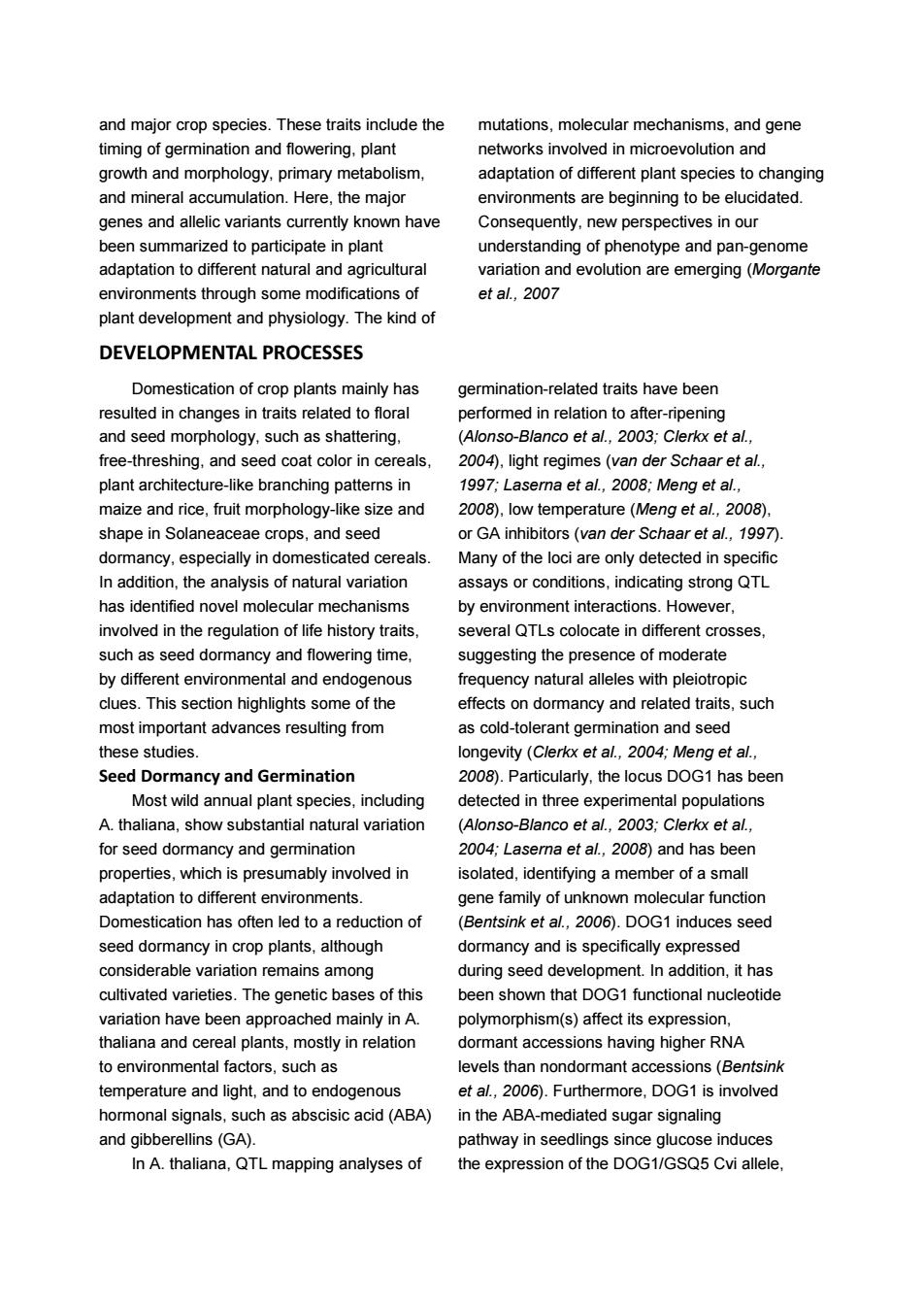正在加载图片...

and major crop species.These traits include the mutations,molecular mechanisms,and gene timing of germination and flowering,plant networks involved in microevolution and growth and morphology,primary metabolism, adaptation of different plant species to changing and mineral accumulation.Here,the major environments are beginning to be elucidated. genes and allelic variants currently known have Consequently,new perspectives in our been summarized to participate in plant understanding of phenotype and pan-genome adaptation to different natural and agricultural variation and evolution are emerging(Morgante environments through some modifications of etal.,2007 plant development and physiology.The kind of DEVELOPMENTAL PROCESSES Domestication of crop plants mainly has germination-related traits have been resulted in changes in traits related to floral performed in relation to after-ripening and seed morphology,such as shattering, (Alonso-Blanco et al.,2003;Clerkx et al.. free-threshing,and seed coat color in cereals, 2004),light regimes (van der Schaar et al., plant architecture-like branching patterns in 1997;Laserna et al.,2008;Meng et al., maize and rice,fruit morphology-like size and 2008),low temperature(Meng et al.,2008). shape in Solaneaceae crops,and seed or GA inhibitors(van der Schaar et al.,1997). dormancy,especially in domesticated cereals. Many of the loci are only detected in specific In addition,the analysis of natural variation assays or conditions,indicating strong QTL has identified novel molecular mechanisms by environment interactions.However, involved in the regulation of life history traits, several QTLs colocate in different crosses, such as seed dormancy and flowering time, suggesting the presence of moderate by different environmental and endogenous frequency natural alleles with pleiotropic clues.This section highlights some of the effects on dormancy and related traits,such most important advances resulting from as cold-tolerant germination and seed these studies. longevity (Clerkx et al.,2004;Meng et al., Seed Dormancy and Germination 2008).Particularly,the locus DOG1 has been Most wild annual plant species,including detected in three experimental populations A.thaliana,show substantial natural variation (Alonso-Blanco et al.,2003;Clerkx et al. for seed dormancy and germination 2004;Laserna et al.,2008)and has been properties,which is presumably involved in isolated,identifying a member of a small adaptation to different environments. gene family of unknown molecular function Domestication has often led to a reduction of (Bentsink et al..2006).DOG1 induces seed seed dormancy in crop plants,although dormancy and is specifically expressed considerable variation remains among during seed development.In addition,it has cultivated varieties.The genetic bases of this been shown that DOG1 functional nucleotide variation have been approached mainly in A. polymorphism(s)affect its expression, thaliana and cereal plants,mostly in relation dormant accessions having higher RNA to environmental factors,such as levels than nondormant accessions (Bentsink temperature and light,and to endogenous et al..2006).Furthermore.DOG1 is involved hormonal signals,such as abscisic acid (ABA) in the ABA-mediated sugar signaling and gibberellins(GA). pathway in seedlings since glucose induces In A.thaliana,QTL mapping analyses of the expression of the DOG1/GSQ5 Cvi allele,and major crop species. These traits include the timing of germination and flowering, plant growth and morphology, primary metabolism, and mineral accumulation. Here, the major genes and allelic variants currently known have been summarized to participate in plant adaptation to different natural and agricultural environments through some modifications of plant development and physiology. The kind of mutations, molecular mechanisms, and gene networks involved in microevolution and adaptation of different plant species to changing environments are beginning to be elucidated. Consequently, new perspectives in our understanding of phenotype and pan-genome variation and evolution are emerging (Morgante et al., 2007 DEVELOPMENTAL PROCESSES Domestication of crop plants mainly has resulted in changes in traits related to floral and seed morphology, such as shattering, free-threshing, and seed coat color in cereals, plant architecture-like branching patterns in maize and rice, fruit morphology-like size and shape in Solaneaceae crops, and seed dormancy, especially in domesticated cereals. In addition, the analysis of natural variation has identified novel molecular mechanisms involved in the regulation of life history traits, such as seed dormancy and flowering time, by different environmental and endogenous clues. This section highlights some of the most important advances resulting from these studies. Seed Dormancy and Germination Most wild annual plant species, including A. thaliana, show substantial natural variation for seed dormancy and germination properties, which is presumably involved in adaptation to different environments. Domestication has often led to a reduction of seed dormancy in crop plants, although considerable variation remains among cultivated varieties. The genetic bases of this variation have been approached mainly in A. thaliana and cereal plants, mostly in relation to environmental factors, such as temperature and light, and to endogenous hormonal signals, such as abscisic acid (ABA) and gibberellins (GA). In A. thaliana, QTL mapping analyses of germination-related traits have been performed in relation to after-ripening (Alonso-Blanco et al., 2003; Clerkx et al., 2004), light regimes (van der Schaar et al., 1997; Laserna et al., 2008; Meng et al., 2008), low temperature (Meng et al., 2008), or GA inhibitors (van der Schaar et al., 1997). Many of the loci are only detected in specific assays or conditions, indicating strong QTL by environment interactions. However, several QTLs colocate in different crosses, suggesting the presence of moderate frequency natural alleles with pleiotropic effects on dormancy and related traits, such as cold-tolerant germination and seed longevity (Clerkx et al., 2004; Meng et al., 2008). Particularly, the locus DOG1 has been detected in three experimental populations (Alonso-Blanco et al., 2003; Clerkx et al., 2004; Laserna et al., 2008) and has been isolated, identifying a member of a small gene family of unknown molecular function (Bentsink et al., 2006). DOG1 induces seed dormancy and is specifically expressed during seed development. In addition, it has been shown that DOG1 functional nucleotide polymorphism(s) affect its expression, dormant accessions having higher RNA levels than nondormant accessions (Bentsink et al., 2006). Furthermore, DOG1 is involved in the ABA-mediated sugar signaling pathway in seedlings since glucose induces the expression of the DOG1/GSQ5 Cvi allele